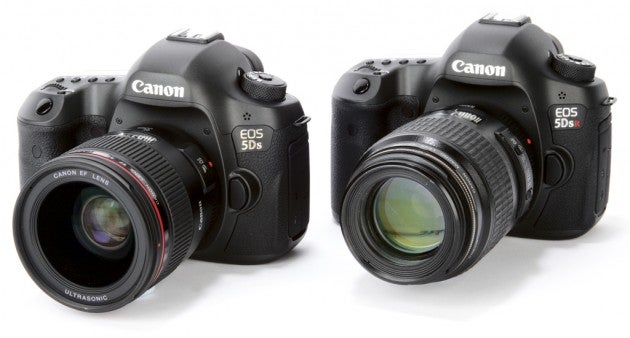In our round up, we take a look at the flagship DSLR models for those who need a professional-level camera, comparing the specs and systems.
There’s plenty of choice if you’re a professional photographer when it comes to choosing a camera system. All of the models we’ve looked at here are full-frame DSLRs. While it’s true that it’s likely you’ll stick with a brand you’ve been used to – some consider switching for a specific feature, so it’s worth keeping an eye out on what rivals are up to every now and then.
Let’s take a look at what those sitting at the top of the DSLR pile have to offer.
Canon EOS 1DX II
Sensor: 20.2MP | Frame rate: 14fps | Video: 4K 60p (up to 29min59s) | Processor: Dual Digic 6+ | Focus Points: 61 point / 41 cross-type | ISO range: 100-51200 (expandable to 50-409600) |
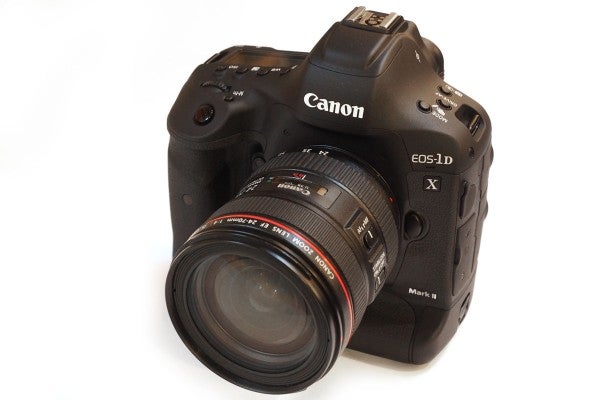
It comes as no surprise that Canon and Nikon both have new professional DSLRs out in the same year – not only are the two fierce rivals keep to outdo each other but 2016 is a year of big sporting events, most notably the Olympics.
Canon’s EOS 1DX II follows on from the original 1DX and features a 20.2 million pixel sensor. That makes it less than half the resolution of the other camera mentioned in this round-up, the Canon EOS 5DS/R. This camera is designed to be a real workhorse camera, being great for action, sport, nature, weddings, and so on – in short it doesn’t need the huge pixel count because it’s not particularly designed to be a studio camera.
The sensor, as well as featuring 61 autofocus points also has Dual Pixel CMOS AF which means focusing is better when using Live View or – perhaps more importantly – when shooting video. 41 of the 61 autofocus point are the more sensitive cross-type, and 5 of which dual-cross type. When shooting at f/8 21 of the points cross-type points will be available which is great for shooting at long telephoto lengths. Autofocus is designed to work to EV-3, which is useful when shooting in extreme low light.
Speaking of video, the EOS 1DX II is the first Canon DSLR to feature 4K video recording. The Nikon D5 has 4K too, but it’s limited to shooting for just five minutes – the Canon bests that attempt with a full 29 minutes and 59 seconds available, making this model more alluring to videographers. Canon says that the 1DX II is designed to replace not only the 1DX but also the video-focused 1DC, so it’s not too much of a surprise to see a heavy emphasis on video specs for the 1DX II.
With so many big sporting occasions in 2016, the 1DX II has to really deliver when it comes to high speed shooting. It can shoot at up to 14fps with full AF/AE tracking, rising up to 16fps when using Live View. The camera is compatible with CFast 2.0 cards which gives you a burst of up to 170 uncompressed 14-bit raw format images before the buffer fills – in short, you should have no problem shooting the entirety of the 100m final at 14fps.
Nikon hit the headlines when it announced the D5’s ISO sensitivity range (see below), but the 1DX is a little more modest. It features the same native range as the original 1DX (100-51,200), but the expanded range is a little bigger topping out at ISO 409,600. Crucially however, there is a new A/D convertor which has been built into the sensor which is designed to reduce image noise.
For professionals working out in the field and needing to send shots back to the office or picture desk, the 1DX II is compatible with the WFT-E8 Wi-Fi adapter, while there’s built in GPS which auto updates the clock in your camera depending on your location. There’s also SuperSpeed USB 3.0 and Gigabit connectivity via Ethernet.
Best professional DSLR for: Sports/Action/News
Read our Canon EOS 1DX II review
See the best deals for the Canon ESO 1DX II
Nikon D5
Sensor: 20.8MP | Frame rate: 12fps | Video: 4K 30p (up to 3 mins) | Processor: EXPEED 5 |
Focus Points: 153 point / 99 cross-type | ISO range: 100-102400 (expandable to 50-3280000) |
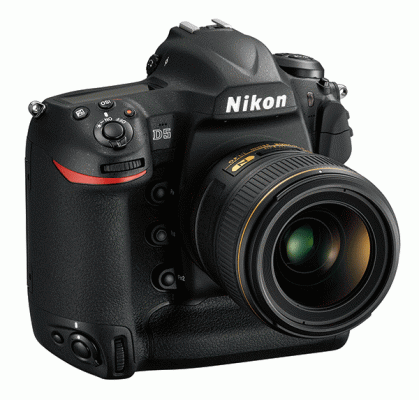
Nikon’s contender is also a very strong performer, with some staggering headline features.
It’s got a 20.8 million pixel full-frame sensor, so there’s not much to pick between the 1DX II and the D5. Again, Nikon has another camera in its range which offers a much higher resolution (the D810), but the 20.8 megapixels here are designed for all-round versatility, especially considering the big emphasis Nikon is placing on low light shooting for this camera.
There’s a 153-point AF system which has an impressive 99 cross-type sensors, with a central point which is usable down to -4EV, on paper at least this beats the capability of the Canon EOS 1DX II and should make the D5 particularly suited to shooting in extreme low light, particularly when paired with the incredibly high ISO speeds that are on offer. Although there are 153-points, it’s worth pointing out that 55 are individually selectable, with the rest acting as support points.
Speaking of which, here the maximum expanded setting is a huge 3,280,000 – that’s not a typo, it’s over 3 million. Of course images taken at this speed don’t boast very high quality, but it means that images taken further down the run, say at ISO 460,000 are incredibly useable. Professional news photographers are likely to find lots of use for this kind of sensitivity level.
Just like the 1DX II, the D5 has been primed for sport and action photography, but it falls just a tiny bit short of the 1DX II with a maximum frame rate of 12fps, rising to 14fps with the mirror up. You can buy the D5 either with dual CF card slots or dual XQD card slots. The latter allows for up to 200 files to be recorded in raw format before the buffer fills up and starts to slow down.
It seems like manufacturers can’t release a camera without 4K video recording anymore, and while the D5 has it, it’s limited to recording for just three minutes. Nikon hasn’t explained why this is, but it could be down to an overheating issue, but it makes it less appealing for working videographers who may find this restriction frustrating.
The D5 has SuperSpeed USB 3.0 connectivity, but just like the Canon 1DX Mark II it doesn’t have built-in Wi-Fi – an optional WT-6 transmitter can be purchased and used with the camera if you need to submit pictures while working remotely.
Best professional DSLR for: News/Sports/Action
See the best deals for the Nikon D5
Canon EOS 5DS/R
Sensor: 50.6MP | Frame rate: 5fps | Video: Full HD 30p (29 mins 59s) | Processor: Dual Digic 6 | Focus Points: 61 point / 41 cross-type | ISO range: 100-6400 (expandable to 50-12800) |
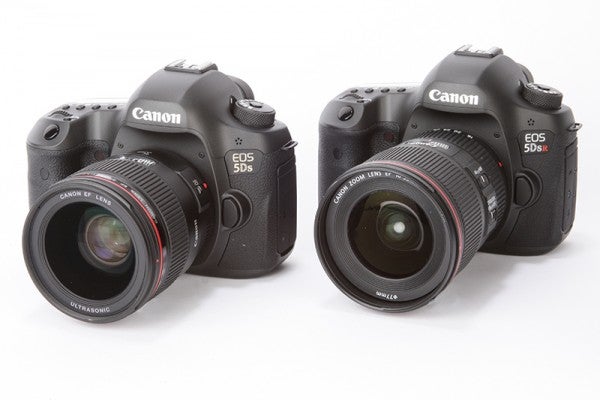
Designed specifically with studio photographers in mind, the 5DS has a whopping 50.6 megapixel sensor. That means that even when you’re using it in crop modes of 1.3x or 1.6x, you still have 30.5 or 19.6 megapixel files to work with.
For the average all-round photographer, all those extra pixels are unnecessary, but for studio, wedding, macro, portrait, and perhaps even landscape photographers – they’re a dream. You can create huge prints at A0 and larger, so advertising and commercial photographers may also be drawn towards it.
Because extra pixels really show up any kind of camera shake, Canon has redesigned the body of the 5DS to incorporate a Mirror Vibration Control System, along with a redesigned shutter mechanism to decrease the possibility of blur.
As well as the standard 5DS, there’s also a 5DSR version available. It has the same sensor, but there’s an optical low pass cancellation filter – a design which boosts resolving power. If you’re somebody who shoots lots of high detailed subjects, then it could be worth spending a little extra money for the R.
There are 61 AF points, of which 41 are cross types, and 5 are double cross-type. That said, the 5DS/R is not really designed for low light shooting, which is reflected by the fact that the native sensitivity only reaches up to ISO 6400, or is expandable up to ISO 12800. It’s also not really a camera which is designed for action and sports photography, with a maximum frame rate of 5fps.
In short, the 5DS/R is a bit more of a niche camera, but if you need a high resolution it could be exactly what you need. If you don’t – you may be drawn more towards the 5D Mark III (see below).
Best professional DSLR for: Studio/Advertising/Commercial
Read our Canon EOS 5DS/R review
See the best deals for the Canon EOS 5DS/R
Canon EOS 5D Mark III
Sensor: 22.3MP | Frame rate: 6fps | Video: Full HD 30p (29 mins 59s) | Processor: Digic 5+ |
Focus Points: 61 point / 41 cross-type | ISO range: 100-25600 (expandable to 102400) |
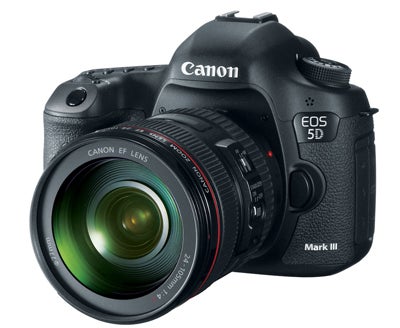
The follow-up to the hugely popular Canon EOS 5D Mark II, the 5D Mark III is a popular choice for many professional photographers as it’s a good all-round performer for a wide range of subjects.
It has a 22.3 million pixel sensor, which is coupled with a Digic 5+ processor for quick speeds. There’s 61 autofocus points, of which 41 are cross-type, and 5 are the even more sensitive double cross-type. This camera is much more suitable to low light shooting, boasting a maximum native sensitivity of ISO 25600 which is expandable up to 102,400, the sensor also has gapless micro lenses which help with light gathering.
Although it can’t quite match the heights of the 1DX II’s 14fps, the 5D Mark III can shoot at 6fps making it reasonably suited to some action and nature subjects. The Digic 5+ processor also means that the buffer clears quite quickly. If you’re somebody who shoots subjects in quiet scenarios – such as wildlife or at weddings, silent drive modes on board the 5D Mark III are very useful (if not literally silent).
The 5D Mark III is well-suited to a wide range of subjects, so if you’re a professional that doesn’t have one particular niche but needs to be able to offer high quality images in diverse conditions, it could be a good investment.
Best professional DSLR for: all-round shooting; weddings, portraits, landscapes, still life, some sports and action
Read our Canon EOS 5D Mark III review
See the best deals for the Canon EOS 5D Mark III
Nikon D810
Sensor: 36.3MP | Frame rate: 5fps | Video: Full HD 60p (29 mins 59s) | Processor: EXPEED 4 | Points: 51 point / 15 cross-type | ISO range: 64-12800 (expandable to 51200) |
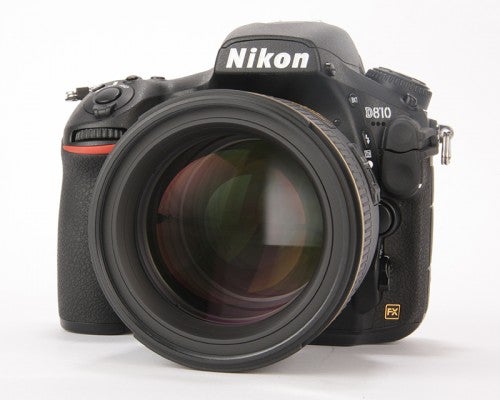
When the D800 was launched, its 36 million pixel sensor created headlines for its incredibly high resolution. The D810 still features that 36 million pixel resolution, but Nikon says that the sensor itself is “all new”. It doesn’t have an optical low pass filter, which means it is capable of producing sharper images than the D800.
The autofocusing system is shared with the D4S, which at the time of the D810’s release was Nikon’s flagship camera. The Multi-Cam 3500F AF module has 51 autofocusing points, with 15 of those being cross-type. Low sensitivity is promised down to -2EV making it great for low light shooting. The ISO range going up to 12800 (expandable up to 51200) also supports that.
While the D810 isn’t designed to be optimised for shooting sports and action, it does have 5fps shooting which can be increased to 6fps if you’re willing to shoot in DX crop mode (which also means shooting at a lower resolution – but with 36 to play with, even half of that number is still good). Another advantage of shooting in DX crop mode is that your lenses will appear to have a longer focal length – that can be really appealing for sports and wildlife photographers needing to get closer to the action.
Full HD video recording is available on the D810, with video being something Nikon was keen to push at the launch of the D810. It has a variety of frame rates, including 60fps – making it faster than the 30fps offered by the Canon EOS 5D Mark III.
Just like Canon’s all-round pro 5D Mark III, the D810 is well suited to those photographers who need to be versatile. It is capable in a range of different conditions, including portraits, weddings, landscapes, and because of its high resolution, for studio settings and for advertising and commercial photographers.
Best professional DSLR for: all-rounder, studio and commercial photographers
Read our Nikon D810 review
See the best deals for the Nikon D810
Nikon D750
Sensor: 24.3MP | Frame rate: 6.5fps | Video: Full HD 60p (29 mins 59s) | Processor: EXPEED 4 | Focus Points: 51 point / 41 cross-type | ISO range: 100-12800 (expandable to 51200) |
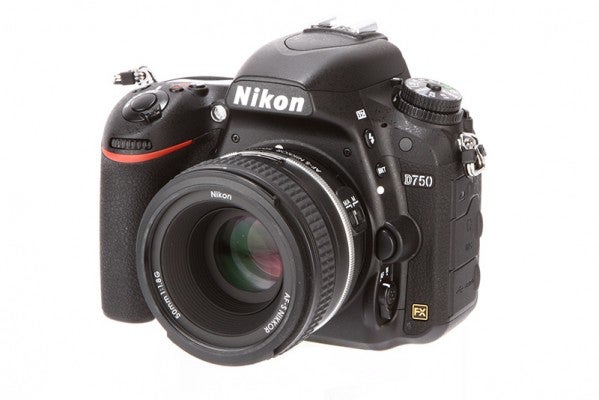
Nikon D750 product shot 1
One of the big things that makes the D750 stand out is that it is the only Nikon or Canon full-frame DSLR to feature Wi-Fi connectivity built into the body itself. For professional photographers working on the field, that can be very, very useful.
It has a 24.3 million pixel sensor, which is the same resolution as the slightly lower specced D610 – Nikon points out that the sensor isn’t the same though and has been developed especially for the D750. Unlike the D810, the D750 has an optical low pass filter which makes it slightly less qualified to shoot high detail subjects.
The D750 is another workhorse camera that needs to be good at a wide variety of different subjects. It has 6.5fps shooting capability, which is decent for sports, action and wildlife – the EXPEED 4 processor means that the buffer clears relatively quickly too.
Low light shooting is facilitated by a 51 point autofocusing system with 15 cross-type points. 11 of the points are intended for use with a teleconverter, making it ideal for wildlife and sports shooting. While the native ISO range is relatively modest, going up to ISO 12800, you can expand it to ISO 51200 if necessary.
Most full-frame DSLR screens are fixed, but not so with the D750 which has a tilting screen. That may not be completely helpful for awkward portrait-format angles, for low down and high up angles, it’s very useful indeed – and could be used by news or wedding photographers looking for a new vantage point.
Video capability is very similar to the D810, with the ability to record Full HD (1920 vs 1080) at the much sought after 60fps. You can also use a Flat Picture Mode to capture colours at a more muted palette which is better suited to video post-production.
This camera is a great all-round camera for any professional photographer, or it could be used as a backup camera for a D810 or D5. Arguably it’s the most suited for news and current affairs photographers who need to file or share pictures quickly from the scene, too.
Best professional DSLR for: news photographers, all-round shooting.
Read our Nikon D750 review
See the best deals for the Nikon D750
Pentax K-1
Sensor: 36.4MP | Frame rate: 4.4fps | Video: Full HD 60p (29 mins 59s) | Processor: Prime IV | Focus Points: 33 point / 25 cross-type | ISO range: 100-204,800 |
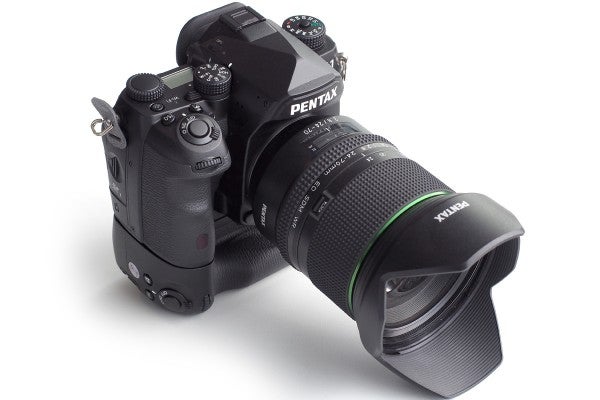
Pentax has taken a long time to release a full-frame DSLR, and it’s likely that many who shot with APS-C cameras have moved over to Nikon or Canon in the intervening time. However, for those that have stuck around with the Pentax brand, the K-1 offers a lot of great features.
For starters it’s got a 36-million pixel full-frame sensor which has 5-axis image stabilisation built in to help reduce image blur in images. The body is weather sealed and there’s plenty of buttons and dials for professionals to get stuck in to. The rear LCD monitor also has a “flex tilt” mechanism which allows it to tilt up and down, but also a little to the left and the right to make it more useful for portrait format shooting.
Low light shooting is well catered for tanks to a sensitivity range of ISO 100 – 204,800, while a 14-bit Prime IV processor comes completed with improved noise reduction algorithms to keep your images clean.
In terms of autofocus, the brand-new SAFOX 12 module has 33 focus points, 25 of which are cross-type. The AF sensor is specified as being sensitive down to -3EV, too.
Video is limited to Full HD (1920 x 1080), and while some may be surprised that a new launch doesn’t feature 4K video recording, Pentax says that this camera is primarily aimed at stills photographers than videographers.
Continous shooting maxes out at 4.4fps, which is on the low-side when compared to the other DSLRs mentioned here, so if you’re a sports, action or wildlife photographer, the K-1 may not be top of your shopping list.
Like the Nikon D750, Pentax has managed to fit built-in Wi-Fi to the K-1. There’s reports that the reason that professional standard cameras such as the Nikon D810 and the Canon EOS 1DX II don’t have such capability is because of tough magnesium bodies – however the K-1 has both, which is excellent to see – again this makes it very desirable for news photographers who need to file images straight away.
The K-1 represents fantastic value for money when compared to some of the other cameras here – but of course you may not already have a range of Pentax lenses – if you do however, you may no longer need to switch to Canon, Nikon (or Sony) if you want to go full-frame, and that’s got to be good news. Whether we’ll begin to see more Pentax models in the hands of working professionals is debatable – but it could happen.
Best professional DSLR for: Pentax legacy users, photographers on a budget
See the best deals for the Pentax K-1
More information:
Full-frame sensors: Advanced technology guide





